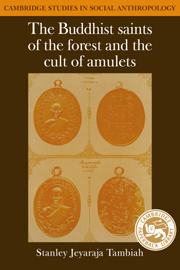Book contents
- Frontmatter
- Contents
- Acknowledgments
- Note on transcription
- 1 Introduction and manifesto
- Part I The arahant and the Path of Meditation
- Part II The hagiography of a Buddhist saint: text and context; the politics of sectarianism
- Part III The cult of amulets: the objectification and transmission of charisma
- 14 The cult of images and amulets
- 15 An enumeration of historic and popular amulets
- 16 The “likeness” of the image to the original Buddha: the case of the Siṅhala Buddha
- 17 The process of sacralizing images and amulets: the transfer of power by monks
- 18 Amulets blessed by contemporary forest saints
- 19 Saints on cosmic mountains
- Part IV Conceptual and theoretical clarifications
- Notes
- Index
- CAMBRIDGE STUDIES IN SOCIAL ANTHROPOLOGY
14 - The cult of images and amulets
Published online by Cambridge University Press: 10 December 2009
- Frontmatter
- Contents
- Acknowledgments
- Note on transcription
- 1 Introduction and manifesto
- Part I The arahant and the Path of Meditation
- Part II The hagiography of a Buddhist saint: text and context; the politics of sectarianism
- Part III The cult of amulets: the objectification and transmission of charisma
- 14 The cult of images and amulets
- 15 An enumeration of historic and popular amulets
- 16 The “likeness” of the image to the original Buddha: the case of the Siṅhala Buddha
- 17 The process of sacralizing images and amulets: the transfer of power by monks
- 18 Amulets blessed by contemporary forest saints
- 19 Saints on cosmic mountains
- Part IV Conceptual and theoretical clarifications
- Notes
- Index
- CAMBRIDGE STUDIES IN SOCIAL ANTHROPOLOGY
Summary
The popularity of amulets in Thailand today
“The tourist,” Griswold has remarked in an essay on the Buddha image, “who comes to Bangkok and visits the monasteries … will see in every vihāra and ordination-hall a Buddha image, nearly always larger than life-size and often colossal, occupying the place of honor; and he will see an indefinite number of lesser ones distributed in halls and galleries – often several hundred of them, and in certain monasteries more than a thousand. Frequently he will see people prostrating themselves before an image, offering flowers and incense, and displaying every sign of fervent devotion. If he goes into the National Museum, he will find that there are more Buddha images than works of any other kind on display. If he goes into a private house, he may find a special room set aside for Buddha images … (and) … they will receive, from time to time, the same sort of homage as in the monasteries.” Griswold might have added that the sense of overwhelming ubiquity of Buddha images in Bangkok is further heightened by their presence by the thousands in shops, particularly the “antique shops”, that have mushroomed in recent times, in response to the tourist trade. These shops are stacked with Buddhas in stone, wood, and metal; gilded to heighten their luster or broken to lengthen their age; many genuinely old and probably lifted from sacred historic sites, and as many modern and faked to look like the classical rarities. This onrush of images into the shops is not disassociated from the recent pillage in Cambodia and the massive smuggling out of northern Burma.
- Type
- Chapter
- Information
- The Buddhist Saints of the Forest and the Cult of Amulets , pp. 195 - 207Publisher: Cambridge University PressPrint publication year: 1984



